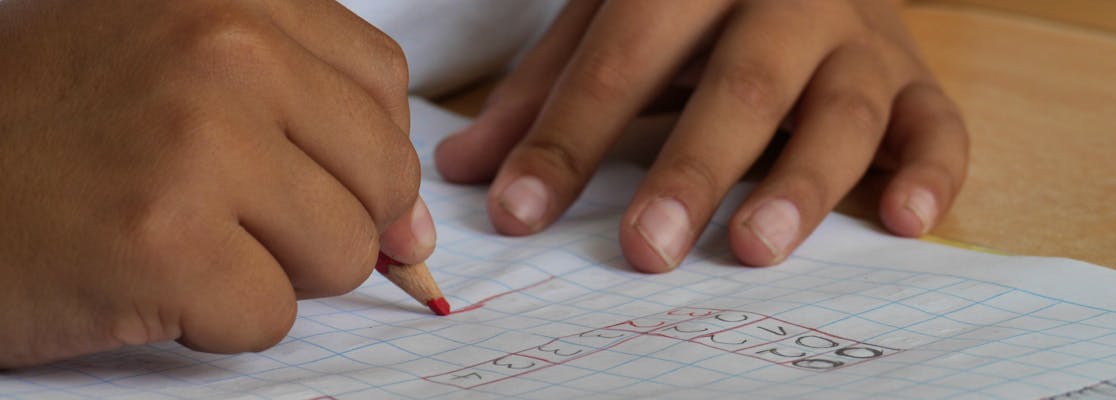The Secondary School Admissions Test (SSAT) – Guide for 2025
All products and services featured are independently selected by WikiJob. When you register or purchase through links on this page, we may earn a commission.
- A List of Secondary School Admissions Tests (SSAT) for Practice in 2025
- What Is the Secondary School Admissions Test (SSAT)?
- What Is Being Assessed On The SSAT Test?
- SSAT - Middle and Upper Level
empty
empty
- What to Expect When Taking the SSAT in 2025?
empty
empty
empty
- Top Tips for Getting a Good Result in the SSAT (2025)
empty
empty
empty
empty
empty
empty
empty
- SSAT - Elementary Level
empty
empty
empty
empty
- How to Gett a Good Result in the SSAT
- Final Thoughts
A List of Secondary School Admissions Tests (SSAT) for Practice in 2025
- SSAT Elementary Level
- SSAT Middle Level
- SSAT Upper Level
What Is the Secondary School Admissions Test (SSAT)?
The SSAT is an admissions test for students in Grades 3 to 11, which is taken as part of an application to an independent or private school, similar to an entrance exam.
It is a standardized way of measuring and comparing students and is used across the world, regardless of educational background.
The SSAT is administered by the Enrollment Management Association and can be taken in schools on certain test dates (standard paper-based), in a Prometric Test Centre (computer-based) or at home (computer-based).
Some schools and educators offer a ‘Flex Paper-Based’ test, which can be taken once in a testing year (1 August – 31 July).

What Is Being Assessed On The SSAT Test?
The SSAT has three levels, depending on the grade of the student:
- Elementary Level: Students in Grades 3 to 4 for entry to Grades 4 to 5
- Middle Level: Students in Grades 5 to 7 for entry to Grades 6 to 8
- Upper Level: Students in Grades 8 to 11 for entry to Grades 9 to 12
There are several timed sections on the test, and these are created to assess different areas of knowledge and education.
These sections include:
- Quantitative (math)
- Verbal (language)
- Reading (comprehension)
- Writing (creative/essay sample)
As part of an application for independent or private schools, these tests assess basic skills that are deemed necessary for a student to be successful in the school.
The tests have the same basic layout at each level, but the difficulty and length of each section are different depending on the SSAT level being taken.
At all levels, each question is multiple-choice. There are five possible answers to each question. The only part of the test that is not multiple-choice is the writing prompt.
SSAT - Middle and Upper Level
Although the difficulty of the questions will vary, the basic layout and number of questions are the same in both the middle level and upper-level tests.
There are 167 questions, including a writing sample, and the test is timed at 3 hours 5 minutes (including breaks).
SSAT Essay
The essay prompt for the middle level offers the student an opportunity to demonstrate creative writing ability, often using a sentence starter or an idea to base their writing on.
At the upper level, there is a choice between a creative prompt and an essay prompt.
The essay prompt is based on a question about a given piece of writing and should be backed up with examples from the text.
SSAT Example Question
1. Write a creative writing essay, with this sentence as the starting point.
“I couldn’t believe that I had finally made it! When I woke up this morning, I never thought…”
After this part of the test, the student will be able to take a five-minute break.
SSAT Quantitative
The math-based word problems for both middle and upper-level students can include formulae, fractions, decimals, shapes and many other basic mathematical functions.
There are 25 questions in this section and it is timed at 30 minutes.
SSAT Example Question
1. Andrew has two jobs. He spent 2.5 hours at the first job, then 5.5 hours at the second. What fraction of a full day did he spend working?
a) 1/4
b) 1/3
c) 3/8
d) 9/12
e) 7/24
The correct answer is: b)
Andrew spent a total of 8 hours working (2.5 + 5.5 = 8).
A full day is 24 hours, so he spent 8/24 hours working.
You will need to simplify this fraction to find the answer.
Divide both the numerator and denominator by the same number to simplify the fraction:
8 ÷ 8 = 1
24 ÷ 8 = 3
or, 1/3
All SSAT Quantitative questions provide space for notes and working out, either in the booklet (paper-based test) or a dry-wipe board (computer-based test).
What to Expect When Taking the SSAT in 2025?
The SSAT test is available in a few different formats.
All tests, whether paper-based or computer-based, have the same number of questions, format and timing – the only difference is the level at which the test is taken (elementary, middle or upper).
SSAT Paper-Based Test
For the paper-based test, the student will be given a pencil and a test booklet.
All the multiple-choice answers should be marked by filling in the appropriate circle, and the writing sample needs to be completed in pencil.
As these are usually taken in a school environment, prohibited items may not be taken into the test room. This includes any electronics, bags, pens and pencils, or watches.
Each section of the test is timed, and students may not move on from the current section until the time is up, regardless of when they have completed it.
The timings are inflexible, so any missed time in any section cannot be made up if the student takes a bathroom break, for example.
The school will receive the test results approximately two weeks after the test date, and parents can log in to their SSAT account to view results.
SSAT Computer-Based at a Prometric Test Center
If the student is taking a test at a Prometric Test Center, the format of the test, number of questions and all the timings are the same as the paper-based test.
The Prometric Test Centers are used for many different types of computer-based testing, so the student may share the test room with adults and students taking a variety of different examinations.
As the student arrives, they will need to confirm their identity, often via a parent or guardian. Students must be aware of prohibited items that may not be brought into the test room; these may be left in the waiting area with a parent or guardian or placed in a locker.
Prohibited items include all electronics including calculators and mobile phones, bags, coats and hats, any stationery including paper and pens. This list is not exhaustive.
It is recommended that the student bring a snack and a drink for consumption in the allocated breaks; these should be in a zip-lock bag.
The computer-based SSAT begins with a tutorial explaining the format and how to answer each question. There may be times when it is appropriate to use the headphones provided to listen to the questions, and the instructions will inform the student when that might be.
Each section will have a five-minute warning before the timed end; students may not move on from the section until the allocated time has passed, even if they have finished the section early.
Results for computer-based tests are generally available online in the SSAT account within four business days.
It is important to note that there is no distinction made between paper-based and computer-based tests; when the scores are shared, the way the test was taken is not noted.
SSAT Computer-Based at Home
The at-home computer-based test is the same as the Prometric Test Center – with similar rules regarding prohibited items.
The test has the same content, length and quality via a secure browser-based option.
The security and efficiency of the computer-based at-home test are important, so the browser uses facial recognition technology, data forensics and video recording to ensure that there are no concerns about cheating.
For information on how the SSAT is scored, read our dedicated article.
If you want 12-month access to all the practice resources for this test, our partner TestPrep-Online.com offers a Family Membership.
Family Membership gives you access to all the TestPrep-Online resources for the next 12 months. You will also get two separate accounts, which can be very helpful if you have two children preparing for their tests.
Get a Family Membership with 12-month access
Top Tips for Getting a Good Result in the SSAT (2025)
1. Read – A Lot
The reading comprehension tests at all levels expect you to understand and interpret text. The best way to revise these skills is to read and practice the reading comprehension section.
When you have read an article or part of a book, think about some questions to answer.
For example,
- Who is telling the story?
- Why did the author use that particular word?
- What nouns, verbs and adjectives are in the text?
2. Synonyms and Analogies
For this part of the test, think about the language you use in speaking and writing. Try and find synonyms for different words as you go about your day.
If you are consciously thinking about more interesting words, you can use them in your written work, too.
3. Brush Up on Math Basics
The quantitative section requires you to have some knowledge about the basic functions in mathematics, like integers, operations, fractions and decimals.
Practicing these, and getting used to completing math word problems, will be a great way to sharpen your skills for the math questions.
4. Be Creative
If you are using a creative writing prompt in the test, it is a great idea to practice writing in creative and interesting ways.
Your creative writing will showcase your abilities to your chosen school, so you want to impress them.
Write stories, dialogue and descriptions, use interesting language and concepts, and let your creativity shine.
5. Practice
Taking SSAT test papers – either official prep packs from the Enrollment Management Association or other training courses – is the best way to understand not only the format and structure of the test but to get used to the timings for each section.
Test takers will find their grade level improve with a study guide and practice.
This is also a good way to understand where you might need more practice – if you get questions wrong in a particular section, you can focus your study there.
SSAT Quantitative
In this test, you will face 25 more word problems relating to mathematical functions, with a 30-minute time limit.
SSAT Example Question
1. Which fraction is closest to 6/13?
a) 1/4
b) 3/8
c) 1/2
d) 2/3
e) 3/4
The correct answer is: c)
There are a few ways to solve this problem but you first need to convert the fractions into a state where they can be compared. Here we have converted each to decimals using long division:
6/13 = 6 ÷ 13 = 0.4615
a) 1/4 = 1 ÷ 4 = 0.25
b) 3/8 = 3 ÷ 8 = 0.375
c) 1/2 = 1 ÷ 2 = 0.5
d) 2/3 = 2 ÷ 3 = 0.667
e) 3/4 = 3 ÷ 4 = 0.75
You can see that the answer closest to 6/13 is c)
SSAT Experimental Section
This is not a marked section of the test, but a set of 16 questions that are presented to test the SSAT paper’s reliability.
Students are encouraged to answer these to the best of their abilities so that the test providers can assess how useful they will be in future test situations.
There is a 15-minute timer on these questions.
SSAT - Elementary Level
The elementary level test contains 89 questions and takes 110 minutes (including built-in breaks).
SSAT Quantitative
This section contains 30 questions and is timed for 30 minutes.
In this part of the test, the student is given word problems around common math functions, including integers, fractions, decimals and basic operations.
SSAT Example Question
1. What is 1,269 – 368?
a) 900
b) 868
c) 1,008
d) 901
e) 1,001
The correct answer is: d)
SSAT Verbal
This section is split into two subsections.
In the first, the student must identify synonyms, and in the second, analogies.
This part of the test contains 30 questions and is timed for 20 minutes. This is the same as for the upper and middle levels, but with a smaller vocabulary requirement.
A short break is scheduled into the test for using the restroom, having a snack or a drink.
SSAT Reading Comprehension
In this section, the student will read several passages and answer relevant questions about them.
At the elementary level, there are seven passages and 28 questions. The questions will be simpler than in the higher levels, and the passages less complex.
SSAT Writing Prompt
The SSAT offers students the opportunity to demonstrate their writing capabilities with a writing sample based on a prompt.
At the elementary level, this prompt is a picture and students are invited to write something based on this.

How to Gett a Good Result in the SSAT
Step 1. Read – A Lot
The reading comprehension tests at all levels expect you to understand and interpret text. The best way to revise these skills is to read.
When you have read an article or part of a book, think about some questions to answer.
For example,
- Who is telling the story?
- Why did the author use that particular word?
- What nouns, verbs and adjectives are in the text?
Step 2. Synonyms and Analogies
For this part of the test, think about the language you use in speaking and writing. Try and find synonyms for different words as you go about your day.
If you are consciously thinking about more interesting words, you can use them in your written work, too.
Step 3. Brush Up on Math Basics
The quantitative section requires you to have some knowledge about the basic functions in mathematics, like integers, operations, fractions and decimals.
Practicing these, and getting used to completing math word problems, will be a great way to sharpen your skills for the math questions.
Step 4. Be Creative
If you are using a creative writing prompt in the test, it is a great idea to practice writing in creative and interesting ways.
Your creative writing will showcase your abilities to your chosen school, so you want to impress them.
Write stories, dialogue and descriptions, use interesting language and concepts, and let your creativity shine.
Step 5. Practice
Taking SSAT test papers – either official prep packs from the Enrollment Management Association or other training courses – is the best way to understand not only the format and structure of the test but to get used to the timings for each section.
This is also a good way to understand where you might need more practice – if you get questions wrong in a particular section, you can focus your study there.
Final Thoughts
Like many other academic tests, the SSAT was designed to give a standardized result that can be used no matter what the student’s background.
The SSAT can be taken in the US, Canada and internationally as part of an application to a private or independent school.
The concepts used are basic enough to be accessible but are difficult enough to challenge students – making them a reliable way of differentiating.
Taking the SSAT can be intimidating, but with good study prep, including taking practice tests, students will understand what is expected of them and can perform well.




